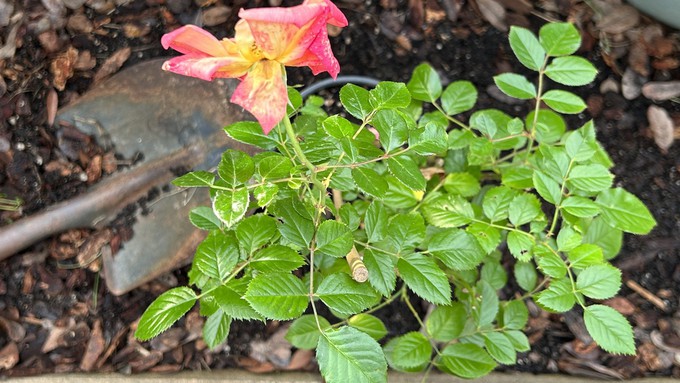
Rose society offers advice on transplanting -- and digging up – rose bushes

Got a rose that needs to be planted, but you're out of space? Learn the options during the Sacramento Rose Society's next meeting Thursday, Jan. 11. (This is a Polynesian Punch floribunda rose, and yes, it needs a permanent space to grow.) Kathy Morrison
There comes a time in every rose gardener’s life: Where are you going to plant another bush?
Often, the answer may be: Take one out.
It’s called “shovel pruning” – the hard choice to dig up a bush that, no matter your efforts, just isn’t performing as expected.
Or maybe this problematic bush is just in the wrong place. Then it needs one more chance – in a better location. How do you transplant a bush that’s already been growing in the ground?
For that matter, what’s the best way to transplant any rose bush – from those that come packed in plastic to others rooted in a supposedly biodegradable pot?
Here’s your chance to find out! Our rosarians will tackle transplanting, shovel pruning and other timely tasks during the January meeting of the Sacramento Rose Society. Moderator Debbie Arrington, a master rosarian and co-creator of Sacramento Digs Gardening, will lead a panel discussion on the different ways to approach these jobs.
January is the best month to transplant roses in our area. The soil is soft from rain, yet still warm enough for root development. Put in the ground now, these new bushes will likely produce roses this spring.
The meeting will be held at 7:30 p.m. Thursday, Jan. 11, at Shepard Garden and Arts Center, 3330 McKinley Blvd., Sacramento, in McKinley Park. Parking and admission are free.
As always, rose society meetings are open to the public. Bring a friend!
Want advice about pruning, fertilization and other aspects of winter rose care? Check out the Winter Rose Care Workshop, hosted by the Sierra Foothills Rose Society. To be held at the Orangevale Grange Auditorium, this free public event will be held Saturday, Jan. 13, starting with registration at 8:30 a.m. and ending with a lunchtime chili cookoff.
Learn more here: https://sacdigsgardening.californialocal.com/article/80414-sierra-foothills-rose-class-2024/.
Comments
0 comments have been posted.Sacramento Digs Gardening to your inbox.
Sites We Like
Garden Checklist for week of July 21
Your garden needs you!
* Keep your vegetable garden watered, mulched and weeded. Water before 8 a.m. to reduce the chance of fungal infection and to conserve moisture.
* Feed vegetable plants bone meal, rock phosphate or other fertilizers high in phosphate to stimulate more blooms and fruiting. (But wait until daily high temperatures drop out of the 100s.)
* Don’t let tomatoes wilt or dry out completely. Give tomatoes a deep watering two to three times a week.
* Harvest vegetables promptly to encourage plants to produce more. Squash especially tends to grow rapidly in hot weather. Keep an eye on zucchini.
* Pinch back chrysanthemums for bushy plants and more flowers in September.
* Remove spent flowers from roses, daylilies and other bloomers as they finish flowering.
* Pinch off blooms from basil so the plant will grow more leaves.
* Cut back lavender after flowering to promote a second bloom.
* It's not too late to add a splash of color. Plant petunias, snapdragons, zinnias and marigolds.
* From seed, plant corn, pumpkins, radishes, winter squash and sunflowers.